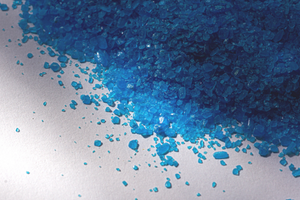The characteristic blue powder with the formula CuSO4 is known as copper (II) sulphate. It is a chemical compound which is broadly applied in many industries. What should you know about it and what is it used for? You can learn that from the article below!

Copper sulphate: the salt of sulphuric acid and copper
Copper sulphate is the salt of sulphuric acid and copper, formed at the second degree of oxidation. This inorganic compound has the form of a crystalline, odourless powder that excellently absorbs water. Anhydrous copper (II) sulphate is white, and turns blue only when combined with water molecules. It can be dissolved in methanol; in its anhydrous form, it will not dissolve in ethanol.
Due to its strongly caustic and hygroscopic properties, copper (II) sulphate is classified as a substance that is extremely hazardous, toxic and non-biodegradable. The use of this salt requires special precautions. Any leak of a CuSO4 solution or a spill of its powder in uncontrolled conditions causes environmental contamination.
How to make a copper (II) sulphate solution?
How can we make a copper sulphate solution? CuSO4 will be formed when we solubilize copper in sulphuric (VI) acid; the acid should be strongly concentrated or heated up and diluted. To obtain a solution, we must pour a rule of powder into a vessel filled with distilled water. Once the crystals dissolve, we will obtain the ready, light blue solution.
In laboratory conditions, the reaction is not the only way to obtain the copper (II) sulphate. This is because we also have the natural, glassy, mineral called chalcanthite, which contains the salt of sulphuric acid and copper. That mineral occurs deeply in the ground, near the beds of copper ore. A specific feature of chalcanthite is that, just like powdered CuSO4, it excellently dissolves in water.
What is technical copper sulphate pentahydrate?
In industrial nomenclature, we sometimes use the term “copper sulphate pentahydrate”. What is it? Its chemical formula resembles that of copper (II) sulphate: CuSO4·5H2O. The difference between them lies only in the content of water molecules: as the name indicates, copper sulphate pentahydrate contains five times more of those molecules. This inorganic compound is also referred to as blue stone or copper vitriol, and shows physico-chemical properties identical to those of CuSO4:
- it is hygroscopic,
- it is strongly irritating to living organisms,
- it has the form of blue crystals, and
- is non-biodegradable.
Copper (II) sulphate: applications
Due to its absorbing and biocidal characteristics, copper (II) sulphate is broadly applied in everyday life and in industry. For decades, the solution of CuSO4 has been known as a high-quality fungicide. It is mainly used to protect wood against diseases caused by fungi. The fungicidal properties of copper sulphate are also appreciated by vets and zootechnicians. Formulations containing the salt of sulphuric acid and copper are among the most efficient agents used in the prevention of fungal diseases of cattle and horses (the decay of hoof fibula, hooves, horns, etc.).
In industry, CuSO4 is also used for so-called copper plating (copper baths) and copper refining. In gardening, it is sometimes applied as an ingredient in fungicides intended for antifungal protection of arable crops.
Copper sulphate pentahydrate: applications
Copper sulphate pentahydrate has the same applications as conventional copper (II) sulphate (CuSO4). The compound can also be used for:
- simple tests for the presence of water molecules in alcohol,
- drying and eliminating mould from different surfaces,
- producing paints and ingredients of construction chemicals and detergents,
- producing impregnates for leathers and various surfaces.
How to apply copper sulphate? The dosage and proportions of the solution in each case time suggested by the manufacturer of that raw material. Please note that copper sulphate may not be used in house conditions without specialised facilities and knowledge of chemistry. Improper use of CuSO4 or CuSO4·5H2O may cause serious poisoning.
- https://pubchem.ncbi.nlm.nih.gov/compound/Cupric-Sulfate
- https://echa.europa.eu/substance-information/-/substanceinfo/100.028.952